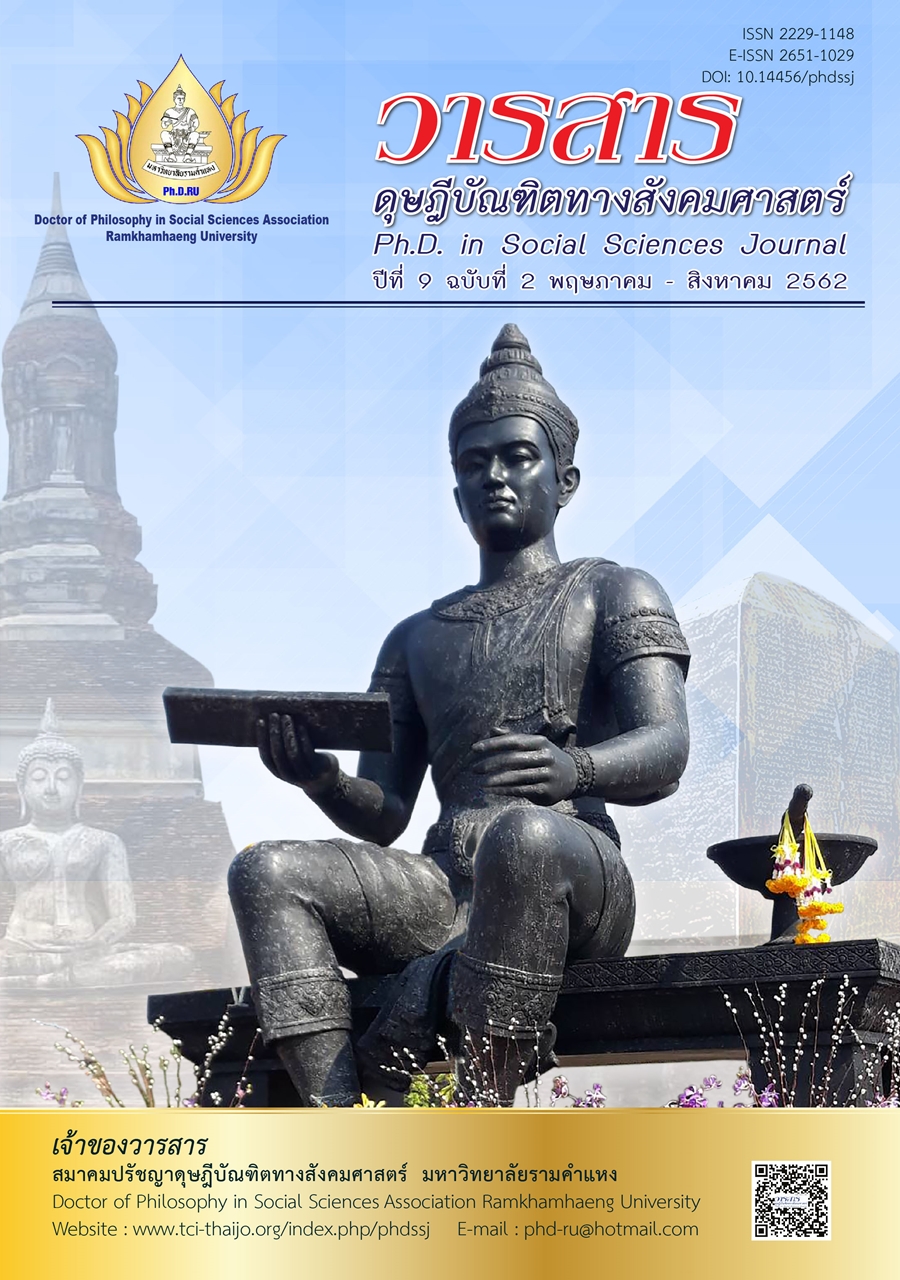ความสัมพันธ์ของภาวะผู้นำเชิงนวัตกรรม ประสิทธิผลของผู้นำ และความสามารถในการแข่งขันของวิสาหกิจขนาดกลางและขนาดย่อมในกรุงเทพมหานคร
Main Article Content
บทคัดย่อ
การวิจัยครั้งนี้มีวัตถุประสงค์เพื่อ (1) เพื่อศึกษาองค์ประกอบของภาวะผู้นำเชิงนวัตกรรมของผู้นำวิสาหกิจขนาดกลางและขนาดย่อม ในกรุงเทพมหานคร (2) เพื่อศึกษาความสัมพันธ์ระหว่างภาวะผู้นำเชิงนวัตกรรม ประสิทธิผลของผู้นำที่ส่งผลต่อความสามารถในการแข่งขันของวิสาหกิจขนาดกลางและขนาดย่อมในกรุงเทพมหานคร กลุ่มตัวอย่างที่ใช้ในการศึกษาครั้งนี้ประกอบด้วย ผู้บริหารของวิสาหกิจขนาดกลางและขนาดย่อมที่เป็นนิติบุคคลจำนวน 420 ชุด เครื่องมือที่ใช้คือแบบสอบถาม การวิเคราะห์สมการโครงสร้าง
ผลการวิจัย พบว่า ผลการวิจัยเชิงปริมาณ พบว่า
1. องค์ประกอบของผู้นำเชิงนวัตกรรม ประกอบด้วย (1) การมีวิสัยทัศน์นำการเปลี่ยนแปลง (2) ความคิดสร้างสรรค์ (3) การทำงานเป็นทีมและการมีส่วนร่วม (4) ความมีจริยธรรม และ (5) บรรยากาศแห่งองค์การนวัตกรรม โดยความคิดสร้างสรรค์มีค่าสัมประสิทธิ์ถดถอยมาตรฐาน เท่ากับ 21 การทำงานเป็นทีมและการมีส่วนร่วมมีค่าสัมประสิทธิ์ถดถอยเท่ากับ 0.94 การมีวิสัยทัศน์นำการเปลี่ยนแปลงมีค่าสัมประสิทธิ์ถดถอย เท่ากับ 0.83 ความมีจริยธรรมมีค่าสัมประสิทธิ์ถดถอยเท่ากับ 0.74 และบรรยากาศแห่งองค์การนวัตกรรมมีค่าสัมประสิทธิ์ถดถอยเท่ากับ 0.72
2. ความสัมพันธ์ระหว่างภาวะผู้นำเชิงนวัตกรรม ประสิทธิผลของผู้นำและความสามารถในการแข่งขันของวิสาหกิจขนาดกลางและขนาดย่อมในกรุงเทพมหานคร ผลการวิจัยพบว่า ผู้นำเชิงนวัตกรรมมีความสัมพันธ์ในทิศเดียวกันกับประสิทธิผลของผู้นำโดยมีสัมประสิทธิ์ เท่ากับ 0.813 ผู้นำเชิงนวัตกรรมมีความสัมพันธ์ในทิศเดียวกันกับความสามารถในการแข่งขันโดยมีสัมประสิทธิ์เท่ากับ 0.305 ประสิทธิผลของผู้นำมีความสัมพันธ์ในทิศเดียวกันกับความสามารถในการแข่งขันโดยมีสัมประสิทธิ์เท่ากับ 0.326 ที่ระดับนัยสำคัญ
Article Details
บทความวิชาการ บทความวิจัย และบทวิจารณ์หนังสือในวารสารดุษฎีบัณฑิตทางสังคมศาสตร์ เป็นความคิดเห็นของผู้เขียน มิใช่ของคณะผู้จัดทำ และมิใช่ความรับผิดชอบของสมาคมปรัชญาดุษฎีบัณฑิตทางสังคมศาสตร์ มหาวิทยาลัยรามคำแหง (กรณีการทำวิจัยในมนุษย์ ผู้วิจัยต้องผ่านการอบรมจริยธรรมการวิจัยในมนุษย์ และนำหลักฐานมาแสดง)
เอกสารอ้างอิง
Bass, B. M., & Avolio, B. J. (1997). Transformation leadership development: Manual for the multifactor leadership questionnaire. Pale Alto, CA: Mindgarden.
Best, J. W., & Kahn, J. V. (2003). Research in education (9th ed.). Boston: Allyn and Bacon.
Cronbach, L. J. (1974). Essentials of psychological testing (3rd ed.). New York: Harper and Row.
George, G., McGahan, A. M., & Prabhu, J. (2012). Innovation for inclusive growth: Towards a theoretical framework and a research agenda. Journal of Management Studies, 49(4), 661-683.
Hair, J., Black, W., Babin, B., Anderson, R., & Tatham, R. (2006). Multiveriate data analysis (6th ed.). Upper Saddle River, NJ: Pearson Prentice Hall.
Horth, D. M., & Vehar, J. (2012). Becoming a leader who fosters innovation. Singapore: Center for Creative Leadership.
Howell, J. M., & Shamir, B. (2005). The role of followers in the charismatic leadership process: Relationships and their consequences. Academy of Management Review, 30(1), 96-112.
Jong, J. P., & Den Hartog, D. N. (2007). How leaders influence employees’ innovative behaviour. European Journal of Innovation Management, 10(1), 41-64.
Leonidas, C. L., Thomas, A. F., Paul, C., Stavroula, S., & Constantine, S. K. (2015). Environmentally friendly export business strategy: Its determinants and effects on competitive advantage and performance. International Business Review, 24, 798-811.
Maina, M. (2012). Total quality operations effectiveness and competitive advantage in horticultural industry in Kenya. Retrieved from http://erepo.usiu.ac.ke/bitstream/handle/11732/1528/Muchara_PHD.pdf?sequence=4&isAllowed=y
Mekvichai, B. ( 2011). Urban development policy. Bangkok: Urban Green Development Institute. [In Thai]
Michael, D. M., Erin, M. T., Cory, H., & Tristan, M. (2017). Cognitive skills and leadership performance: The nine critical skills. The Leadership Quarterly, 28(1) 24-39.
Ministry of Information and Communication Technology. (2016). Digital development plan for economy and society. Retrieved from http://www.mict.go.th/assets/portals/1/files/590613_4Digital_Economy_Plan-Book.pdf [In Thai]
National Innovation Agency. (2004). Innovation management for executives. Bangkok: Ministry of Science and Technology. [In Thai]
Porter, M. E. (1985). Competitive advantage: Creating and sustaining superior performance. New York: The Free Press.
Punthai, B. (2014). Introduction to educational research methodology (3th ed.). Bangkok: Ramkhamkaeng University Press. [In Thai]
Sooksan, K., & Gayle, C. A. (2010). The power of vision: Statements that resonate. Journal of Business Strategy, 31(1), 37-45.
Sydänmaanlakka, P. (2003). Intelligent leadership and leadership competencies: Developing a leadership framework for intelligent organizations. Retrieved from https://aaltodoc.aalto.fi/handle/123456789/2042
Thongrawd, C. (2007). SME leadership in a situation of economic crisis and the survival of SME industrial. Journal of the Association of Researchers, 12(2), 106-112. [In Thai]
Vanichbuncha, K. (2010). Using SPSS for windows for data analysis (16th ed.). Bangkok: Thammasarn. [In Thai]


